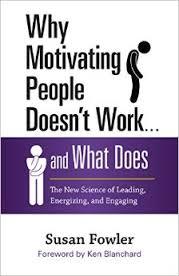
How do you motivate people?
You don’t.
A leader’s job is to create the conditions whereby a motivated person can excel.
It’s counterintuitive because leaders have typically been told that their job is to motivate their team. Yet a growing body of social science evidence suggests that typical workplace carrot-and-stick motivation techniques are superficial and provide short-term results, at best.
With the estimated $350 BILLION a year lost to disengaged people, motivation is a hot topic for leaders.

Workplace expert Susan Fowler says, “We think that because people need or want money, that’s what motivates them.” Fowler, the senior consulting partner with the Ken Blanchard Companies, says the latest research indicates that people don’t understand the nature of their own motivation. Fowler says, “When they are unhappy at work, they ask for more money. They yearn for something different—but they don’t know what it is—so they ask for the most obvious incentive: money.”
Fowler says that money is filling our psychological need for competence, and it’s a measuring tool. But it does not sustain long-term motivation.
In her new book, Why Motivating People Doesn’t Work . . .and What Does, Fowler argues that leaders still depend on traditional carrot-and-stick techniques because they aren’t aware of their alternatives.
The new science of motivation, says Fowler, “is that human beings have an inherent desire to thrive, people want to make a contribution, people don’t want to be disengaged, but they haven’t had the words to describe these drives.“
“Motivation,” she says, “is one of the most vital and essential aspects of leadership and one of the most confused and misunderstood.
Why the big disconnect? Fowler says, one reason is that leaders depend on their observations of external behaviors and conditions to evaluate their employees’ motivation. Unfortunately, many leaders are not perceptive observers, nor are they wise interpreters of what they see.
In her Why Motivating People Doesn’t Work, Fowler outlines five mistaken beliefs that erode workplace engagement: 
1. It’s not personal, it is just business.
This minimizes the validity, and thus, the potential impact of people’s feelings. People spend the better part of their waking hours at work; of course it’s personal. When you depersonalize work, you erode emotional engagement.
2. The purpose of business is to make money.
Business must make a profit, but assuming that profit is the primary purpose puts the focus on short-term metrics instead of long-term impact. This reduces your employees to transactional mindset, thus, they’re more inclined to check the box and go home.
3. Leaders are in a position of power.
How many CEO’s have tried to implement new strategies and failed? It’s not because they don’t have the power, it’s because they don’t have support. Fowler says, the more effective belief is, “Leaders are in a position of empowering others.”
4. The only thing that really matters is results.
This is a hard belief to challenge, yet Fowler suggests, “Too often, the way metrics are framed promotes a negative internalizing of goals—feeling pressured or bribed into action—eroding any sense of autonomy or relatedness.” Fowler says, “You can help people shift to a more optimal motivational outlook by clarifying the underlying values behind your dashboard metrics.” It’s not just the results, but also why and how people achieve them.
5. If you cannot measure it, it doesn’t matter.
“Squishy” feelings like passion, commitment and trust are the underpinnings of great organizations. Fowler says, “If you can not measure it, it is probably really, really, important.”